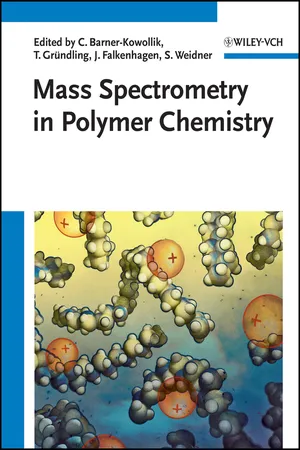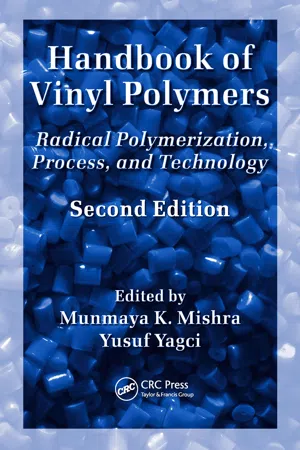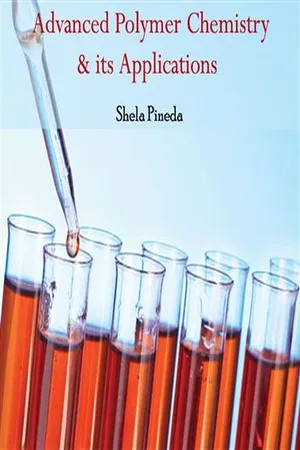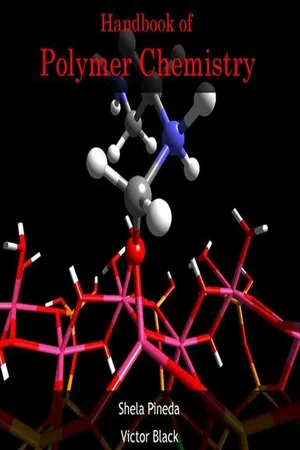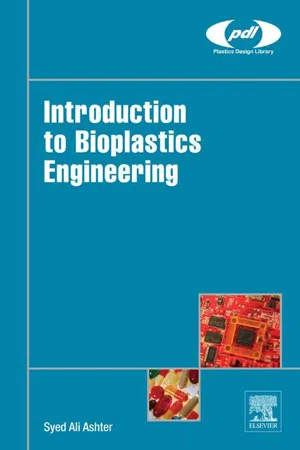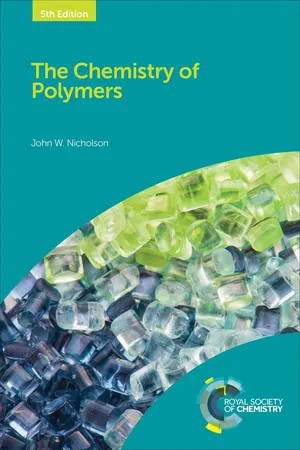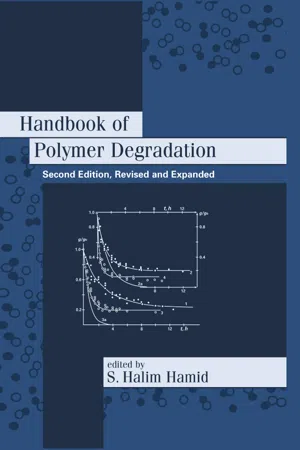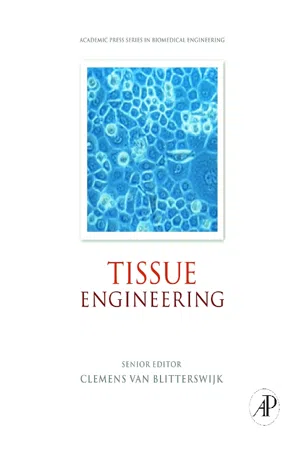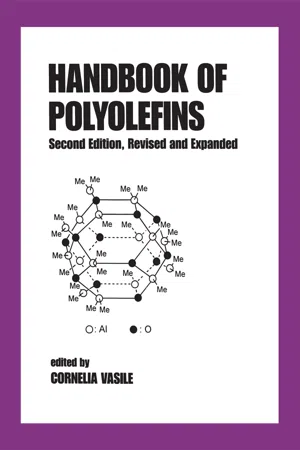Chemistry
Polymer Degradation
Polymer degradation refers to the breakdown of polymer materials due to various factors such as heat, light, chemical reactions, or mechanical stress. This process can lead to changes in the physical and chemical properties of the polymer, ultimately affecting its performance and lifespan. Understanding and controlling polymer degradation is crucial in the development of durable and sustainable materials.
Written by Perlego with AI-assistance
Related key terms
1 of 5
11 Key excerpts on "Polymer Degradation"
- eBook - ePub
- Christopher Barner-Kowollik, Till Gruendling, Jana Falkenhagen, Steffen Weidner, Christopher Barner-Kowollik, Till Gruendling, Jana Falkenhagen, Steffen Weidner(Authors)
- 2012(Publication Date)
- Wiley-VCH(Publisher)
Chapter 13 Polymer Degradation Paola Rizzarelli, Sabrina Carroccio, and Concetto Puglisi 13.1 IntroductionPolymer Degradation is one of the most important areas of polymer chemistry, being a major factor restraining application of these outstanding and versatile materials. The idiom “Polymer Degradation” takes account of different processes, induced by one or more environmental factors such as heat, light, microorganisms, or chemicals that deteriorate polymers producing alterations in their properties. The degradation is the result of irreversible changes that are usually undesirable or, in some cases, required, as in biodegradation or recycling, or else induced to support structure determination.Degradation plays an important role in every life phase of a polymer, that is, during its synthesis, processing, use, and even after it has accomplished its planned purpose. As a result, stabilization is required to extend the life time of most polymers. Compounding with stabilizers is the preferred and well-established method for improving stability. However, monitoring and controlling degradation requires the understanding of many different phenomena, including the diverse chemical mechanisms underlying structural changes in macromolecules, the complex reaction pathways of additives, the interactions of fillers, as well as impurities, and the complicated relationship between molecular-level changes and macroscopic properties.Various schemes to classify Polymer Degradation exist. Because of its complexity, with regard to both the causes and the response of the polymer, classification is usually performed on the basis of the dominating features. We will refer to the classification based on the main factors responsible for degradation: thermal, thermo-oxidative, photo, photo-oxidative, hydrolytical, chemical, biological degradation, and so on. - eBook - PDF
Handbook of Vinyl Polymers
Radical Polymerization, Process, and Technology, Second Edition
- Munmaya Mishra, Yusuf Yagci, Munmaya Mishra, Yusuf Yagci(Authors)
- 2016(Publication Date)
- CRC Press(Publisher)
Most commercial polymers are manufactured by processes involving chain polymerization, poly-addition, or poly-condensation reactions. These processes are generally controlled to produce individual polymer molecules with defined Molecular weight (or molecular weight distribution) Degree of branching Composition Once the initial product of these processes is exposed to further shear stress, heat, light, air, water, radiation, or mechanical loading, the chemical reactions started in the polymers will have the net result of changing the chemical composition and the molecular weight of the polymer. These reactions in turn lead to a change in the physical and optical properties of the polymer. In practice, any change of the poly-mer properties relative to the initial desirable properties is called degradation. In this sense, “degradation” is a generic term for any number of reactions that are possible in a polymer. Degradation of polymers can be brought about by either physical factors, • • • 14.12 Differential Scanning Calorimetry and Differential Thermal Analysis .................................................................................................... 448 14.13 Mass Spectrometry ................................................................................... 449 14.14 Coupled Instrumental Techniques for the Characterization of Polymer Degradation ............................................................................ 449 References .............................................................................................................. 450 Vinyl Polymer Degradation 431 such as heat, light, and mechanical stress, or by chemical agents such as oxygen, ozone, acids, and alkalis. In the following sections of this chapter, emphasis will be made to discuss elaborately the different types of degradations encountered in poly-meric materials and their mechanistic aspects. - No longer available |Learn more
- (Author)
- 2014(Publication Date)
- Learning Press(Publisher)
________________________ WORLD TECHNOLOGIES ________________________ Chapter-4 Polymer Degradation Polymer Degradation is a change in the properties - tensile strength, colour, shape, etc. - of a polymer or polymer-based product under the influence of one or more environmental factors such as heat, light or chemicals such as acids, alkalis and some salts. These changes are usually undesirable, such as cracking and chemical disintegration of products or, more rarely, desirable, as in biodegradation, or deliberately lowering the molecular weight of a polymer for recycling. The changes in properties are often termed aging. In a finished product such a change is to be prevented or delayed. Degradation can be useful for recycling/reusing the polymer waste to prevent or reduce environmental pollution. Degradation can also be induced deliberately to assist structure determination. Polymeric molecules are very large (on the molecular scale), and their unique and useful properties are mainly a result of their size. Any loss in chain length lowers tensile strength and is a primary cause of premature cracking. Commodity polymers Today there are primarily seven commodity polymers in use: polyethylene, poly-propylene, polyvinyl chloride, polyethylene terephthalate or PET, polystyrene, polycar-bonate, and poly(methyl methacrylate) (Plexiglass). These make up nearly 98% of all polymers and plastics encountered in daily life. Each of these polymers has its own characteristic modes of degradation and resistances to heat, light and chemicals. Polyethylene, polypropylene, and poly(methyl methacrylate) are sensitive to oxidation and UV radiation, while PVC may discolour at high temperatures due to loss of hydrogen chloride gas, and become very brittle. PET is sensitive to hydrolysis and attack by strong acids, while polycarbonate depolymerizes rapidly when exposed to strong alkalis. - No longer available |Learn more
- (Author)
- 2014(Publication Date)
- Academic Studio(Publisher)
________________________ WORLD TECHNOLOGIES ________________________ Chapter 4 Polymer Degradation Polymer Degradation is a change in the properties - tensile strength, colour, shape, etc. - of a polymer or polymer-based product under the influence of one or more environmental factors such as heat, light or chemicals such as acids, alkalis and some salts. These changes are usually undesirable, such as cracking and chemical disintegration of products or, more rarely, desirable, as in biodegradation, or deliberately lowering the molecular weight of a polymer for recycling. The changes in properties are often termed aging. In a finished product such a change is to be prevented or delayed. Degradation can be useful for recycling/reusing the polymer waste to prevent or reduce environmental pollution. Degradation can also be induced deliberately to assist structure determination. Polymeric molecules are very large (on the molecular scale), and their unique and useful properties are mainly a result of their size. Any loss in chain length lowers tensile strength and is a primary cause of premature cracking. Commodity polymers Today there are primarily seven commodity polymers in use: polyethylene, poly-propylene, polyvinyl chloride, polyethylene terephthalate or PET, polystyrene, poly-carbonate, and poly(methyl methacrylate) (Plexiglass). These make up nearly 98% of all polymers and plastics encountered in daily life. Each of these polymers has its own characteristic modes of degradation and resistances to heat, light and chemicals. Polyethylene, polypropylene, and poly(methyl methacrylate) are sensitive to oxidation and UV radiation, while PVC may discolour at high temperatures due to loss of hydrogen chloride gas, and become very brittle. PET is sensitive to hydrolysis and attack by strong acids, while polycarbonate depolymerizes rapidly when exposed to strong alkalis. - eBook - ePub
- Syed Ali Ashter(Author)
- 2016(Publication Date)
- William Andrew(Publisher)
3Mechanisms of Polymer Degradation
Abstract
Polymers are a broad class of materials that can be natural in origin or synthetic. Very small variations in the chemical structures of polymer could lead to large changes in their biodegradability. In a typical degradation process, polymers are first converted into their smaller units, after which the process of mineralization starts. Most polymers comprise of extremely large-chain molecules and must be broken down to smaller units called monomers via depolymerization. These smaller units are then absorbed by microbial cells and then biodegraded. The biodegradability of polymers depends on the molecular weight, molecular form, structure, and crystallinity. It decreases with increase in molecular weight, while monomers, dimers, and repeating units (all of them?) degrade easily. This chapter focuses on degradation mechanism of five different engineering polymers, some of which are commercially available and some that has potential for the future.Keywords
Biodegradability; thermal degradation; photo-oxidation; thermal oxidation; depolymerization; hydrolysis3.1 Introduction
Polymers are a broad class of materials that are made from repeating units of smaller molecules called monomers. Polymers can be natural in origin or synthetic. Polymer obtained from lignin of the tree branches is considered natural while anything that is made by humans from naturally occurring materials is considered synthetic [1] . Very small variations in the chemical structures of polymer could lead to large changes in their biodegradability. Biodegradability depends on the molecular weight, molecular form, structure, and crystallinity. It decreases with increase in molecular weight, while monomers, dimers, and repeating units degrade easily.There are three main biodegradation mechanisms [2] - eBook - PDF
- R.G. Compton, C.H. Bamford, C.F.H. Tipper†(Authors)
- 1975(Publication Date)
- Elsevier Science(Publisher)
Chapter 1 Thermal Degradation of Polymers C. DAVID 1. Introduction One of the main interests of the polymer chemist is to develop new polymers that have good mechanical properties at high temperature and to improve the thermal stability of existing polymers. Extensive studies of the mechanism of thermal degradation of the presently available macro- molecules are very helpful in this field. Heat treatment of polymers may affect either the main chain linkages (often carbon-carbon bonds) or substituent atoms and side chains. Scission of the main chain often gives free radicals and can occur either at random in the chain or at weak links resulting from anomalous structures as in poly-a-methylstyrene and polyethylene. Also the chain ends often present labile structures suitable for initiation of thermal degradation. This is observed with polymethylmethacrylate chains terminated by double bonds. The macro-radicals formed by the rupture of the main chain can undergo depolymerization by a chain reaction the length of which varies according to the structure of the polymer and the temperature. They can also be involved in inter- or intramolecular transfer as in polystyrene and polyethylene heated at moderate temperature. A decrease in molecular weight is then often observed. Formation of crosslinks sometimes occurs if the main chain contains double bonds. An example of this is network formation in polyvinylchloride at unsaturated linkages formed under heat treatment. Reactions at the site of side chains or substituents of the main chain can also markedly affect the polymer properties. Elimination reactions of the type have been identified with PVC. Radicals are not necessarily involved. If conjugated sequences of double bonds are formed, discolouration of the sample ensues. A free radical formed by side-chain breakage can also induce main-chain scission according to References p p . 165-1 73 - eBook - ePub
- John W Nicholson(Author)
- 2017(Publication Date)
- Royal Society of Chemistry(Publisher)
Compounds for use as antioxidants have to fulfil a number of requirements in addition to their effectiveness in stabilising the polymer. For example, they must have low toxicity and be inexpensive. They must also be fully compatible with the polymer of choice since otherwise they tend to migrate to the surface where they impart an unacceptable appearance. Any such migration also depletes the concentration in the bulk which leads to a loss of protection for the polymer.8.7 Biological Degradation of Polymers
The major commercial polymers are the polyolefins, poly(ethylene) and poly(propylene), and these are extremely resistant to biological degradation. Some degree of biodegradability can be conferred by copolymerising the principal monomer with a more polar monomer, typically an ester. Alternatively, blending the polyolefin with a highly biodegradable polymer, such as starch, can be employed. Such materials do not fully degrade since the polyolefin continues to resist such degradation. However, the product of degradation tends to be a finely divided powder, rather than large pieces of polymeric debris, and this may be less obtrusive in the environment.Synthetic polyesters are capable of being degraded by microorganisms, polyesters with aliphatic backbones being more susceptible to such degradation than those with aromatic backbones. Polyamides of low molar mass, too, may be degraded by microorganisms, but commercial polyamides, the nylons, tend to be of too great a molar mass and hence are almost completely resistant to biological attack.On the other hand there are polymers that are capable of being degraded, generally in a controlled way, to yield low molar mass molecules that can be safely metabolised by living organisms. Polymers of this type need to have relatively polar substituents, preferably ester and hydroxyl groups. One such polymer that has achieved some technical success, for example as a material for biodegradable packaging, is poly(hydroxybutyrate) (PHB).Biodegradation is an enzyme-catalysed process, and typically occurs in two stages. In the first of them, the enzyme binds to the polymer, after which, in the second stage, hydrolytic cleavage occurs. Generally the more hydrophilic the polymer, the more susceptible it is to hydrolysis. However, other factors also affect the susceptibility towards hydrolysis, such as molar mass and crystallinity. Lower molar mass polymers degrade quicker than their higher molar mass analogues, and amorphous regions of semicrystalline polymers degrade more readily than the crystalline regions. - eBook - PDF
- S. Halim Hamid(Author)
- 2000(Publication Date)
- CRC Press(Publisher)
This was probably because of the short period during which the samples were studied. We have suggested that PE biodegradation in soil consists of three distinct phases. In the first phase, there is a slow and constant degradation rate. The second phase consists of decline in degradation rate, as determined by mineralization studies with labeled material. The third and final phase is character-ized by a return to a slow and constant degradation rate that could lead to the final destruction and mineralization of the material (65). During synthesis and degra-dation of polyesters we found similar degradation phases (66,67). IV. MEANS OF INCREASING BIODEGRADABILITY Degradable polymers are materials with inherent sensitivity to different degradation factors. A degradation is performed by physical, chemical, mechanical, or biological agents. To answer the need of ultimate disposability or recyclability of plastic materials, great efforts have been made to develop degradable polymers, thus prohibiting the irreversible buildup of these materials in the environment. Several means are used to achieve degradability. The repetitive chain of the polymer is either hydrolyzable, oxidizable, or thermolabile. Some polymers are sensitive to biodegradation by enzymes or microorganisms or both, whereas others in later stages of deterioration are biodegraded. Addition ofbiopolymers to synthetic Biodegradation of Polymers 425 polymers renders the materials more susceptible to autoxidation owing to the porous matrix left after degradation of the biopolymeric additive. The methods that have emerged for degradable polymers are the following: 1. Photo oxidizable degradable polymers 2. Directly biodegradable polymers 3. Autoxidizable polymers that then biodegrade 4. Water-soluble polymers 5. New forms of natural polymers The combining of several modes of degradation in a material is a successful way to render a plastic degradable. - eBook - PDF
Polysaccharides
Structural Diversity and Functional Versatility, Second Edition
- Severian Dumitriu(Author)
- 2004(Publication Date)
- CRC Press(Publisher)
The extent of the effect depends on the experimental conditions, polysaccharide structure, confor-mation, and other characteristics. The predominant mech-anism for the chain scission was the breakdown of the glycosidic bonds in the macromolecule, a well-known mech-anism, which occurs in a wide range of polysaccharides. III. BIODEGRADATION PROCESSES Biodegradation was defined as an event that take place in the natural environment and in living organisms [38,39]. Biodegradation, as well as other processes of degradation, is dependent on the chemical structure of the polymers (or biopolymers) because it is fundamental how easily they can be attacked by microorganisms. The hydrolysis process is also dependent on the local order of the macromolecule. Unordered macromolecules are more susceptible to hydrol-ysis (acid hydrolysis). Complex macromolecules, such as lignin, which is a natural polymer, are less degradable than synthetic polymers like aliphatic polyesters, confirming that the molecular composition and architecture determine the accessibility of a polymer to degradation by micro-organisms. As described by Ratajska and Boryniec [40], the mechanism of biodegradation by microorganisms primar-ily occurs through an attack on the surface of the biode-gradable fragments. By removing the fragments, the porosity of the material increases, allowing the permeation of water with the microorganisms that may cause mechan-ical stress facilitating the process of degradation by the enzymes produced. The processes of biodegradation described in the literature are, in general, associated with the hydrolysis caused by added enzymes or those produced by the micro-organisms, and can be followed by changes in molecular weight, viscosity, and morphology. - eBook - PDF
- Jan De Boer, Clemens van Blitterswijk, Peter Thomsen, Jeffrey Hubbell, Ranieri Cancedda, J.D. de Bruijn, Anders Lindahl, Jerome Sohier, David F. Williams(Authors)
- 2008(Publication Date)
- Academic Press(Publisher)
These polymers have hydrolytically very labile bonds in their main chains, which react with water rapidly. Therefore, the degradation process occurs at the poly-mer surface resulting in a surface eroding material. 7.4.4 In vivo degradation In the development of a novel degradable polymer, most degradation experiments are performed in vitro by incubating the polymeric specimen in phosphate buffered saline (PBS) at body temperature (37°C) to study the degradation mechanism. However, in vitro degradation behaviour can considerably differ from in vivo degradation. In most cases in vivo degrad-ation is faster than in vitro degradation (Fulzele et al ., 2003; Lu et al ., 2000; Mainil-Varlet et al ., 1997; Menei et al ., 1993; Spenlehauer et al ., 1989; Stoll et al ., 2001; Tracy et al ., 1999). The faster in vivo deg-radation can be attributed to the tissue response (Ali et al ., 1994; Stoll et al ., 2001). Acute inflammation, due to the injury of implantation, and foreign body reaction, due to the presence of the implant, induce the migration of polymorphonuclear leucocytes and macrophages to the implant site (Anderson, 1994; Anderson and Shive, 1997). Reactive species, like super oxide and hydrogen peroxide species, produced by these inflammatory cells can oxidize the polymer chains (Deschamps et al ., 2002; Goedemoed et al ., 1998). Therefore, the in vivo decrease in molecular weight values is not only due to hydrolytic degrad-ation caused by the extracellular fluid, but probably also by the influence of the oxygen free radicals and of the other species generated by the inflammatory cells (Ali et al ., 1994). In some cases however, such as in hydrogel-like polymer systems, a slower in vivo deg-radation has been reported compared to the in vitro degradation in phosphate buffer (Changez et al ., 7.4 Mechanisms of Polymer Degradation and erosion 207 - eBook - PDF
- Cornelia Vasile(Author)
- 2000(Publication Date)
- CRC Press(Publisher)
J Polym Sci Symp 57: 161, 1976 107. A Kaczmarek, JF Rabek. Angew Makromol Chem 247, 111-130, 1997; JF Rabek. Polymer Photodegradation. Mechanisms and Experimental Methods. London: Chapman & Hall, 1995. 108. Z Osawa, T Saito. Stabilization and Degradation of Polymers. Adv Chem Ser. 169, 1978, p 159. 109. Z Osawa, K Kobayashi, E Kayano. Polym Degrad Stab 11: 63, 1985. 110. NM Livanova, GE Zaikov. Int J Polym Mater 36: 23-31, 1997; Polym Degrad Stab 57: 1-5, 1997. 111. F Yoshii, G Meligi, T Sasaki, K Makunchi, AM Rabie, S Nashimoto. Polym Degrad Stab, 49: 315, 1995. 112. T Sterzynski, M Thomas. J Macromol Sci Phys B-34: 119, 1995. Degradation and Decomposition 469 113. I Manaf, F Yoshii, K Makouchi. Angew Makromol Chem227: 111, 1995. 114. MS Rabello, JR White. J Appl Polym Sci 64: 2505-2517, 1997. a. S Nishimoto, T Kagiwa. In: SH Hamid, MB Amin, AG Maadhah, eds. Handbook of Polymer Degradation. New York: Marcel Dekker, 1993. 115. a. M. Iring, S Laszlo-Hedvig, T. Kelen, E Tiidiis. J Polym Sci Symp 57: 55, 65, 89, 1976. b. M Iring, S Laszlo-Hedvig, E Tiidos, T. Kelen. Polym Degrad Stab 5: 467, 1983. 116. DJ Carlsson, R Brousseau, C Zhang, DM Wiles. In: JL Benham, JE Kinstle, eds. ACS Symp. Series No. 364, 1988, chap 27, p 376; Polym Degrad Stab 17: 303, 1987. 117. HP Frank. Polym Eng Sci 20: 678, 1980; R Pazur, M Troquet, JL Gardette. J Appl Polym Sci Polym Chem Ed 35(9): 1689-1701, 1997. 118. L Matisova-Rychla, J Rychly. In: RL Clough, NC Billingham, KT Gilen, eds. Adv Chem Series 249, 1993 Polymer Durability pp 175-193. 119. WL Hawkins, W Matreyek, EH Winslow. J Polym Sci 41: 1, 1959. 120. EH. Winslow, JC Aloisio, WL Hawkins, W Matreyek, S Matsuoka. Chem Ind (London) 533; 1465, 1963. 121. E Tiidos, M Iring, Acta Polym 39: 19, 1988; Prog Polym Sci 15: 217, 1990. 122. A Tidjani, R Arnaud, A Dasilova. J Appl Polym Sci 47(2): 211-216, 1993. 123. NL Maecker, DB Priddy. J Appl Polym Sci 41: 21-32, 1991.
Index pages curate the most relevant extracts from our library of academic textbooks. They’ve been created using an in-house natural language model (NLM), each adding context and meaning to key research topics.
